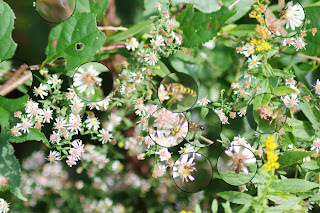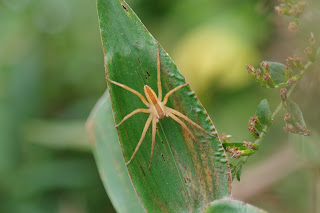Backyard Bug of the Day:
Beetle. Sitting on a rock in the rock garden. It was so cooperative I thought it was dead, but later it was walking around on the rock.
The most popular flowers in the backyard (practically the only flowers, now that most of the goldenrod has finished blooming) are the asters:
I tried to get a picture showing how many sweat bees were on this patch of flowers, but they all immediately flew away. However, there are still a lot of insects here...
Mostly ants, but one bee and a hover fly.
Elsewhere in the backyard, on another patch of asters:
The sweat bees were more cooperative.
And there were a lot of them.
Some kind of hairstreak butterfly. I couldn't figure out what kind it is. It's pretty beat up.
And of course, with all of those insects to eat, there are assassin bugs to eat them.
Tree cricket
I have never seen a woolly bear with that extra patch of brown by the head. This one is covered in parasites. It looks quite sickly.
Another sickly looking caterpillar.
Ichneumon wasp
A while back I posted a picture of this cocoon, and have forgotten to check on it since. Today I finally remembered where it was, and had a look, and was surprised to see this... stuff on the outside. I thought it was some kind of fungus, but when I looked at the pictures I remembered a situation from a couple of years ago. I had seen a white marked tussock moth caterpillar on the trunk of a tree, and it sat there for a couple of days, and then one day where it had been was a cocoon that looked like this. Then some time later I checked on it and saw that a moth had emerged; it was a female, and the female white marked tussock moth doesn't have wings. She emerges from her cocoon and just waits there for a mate to come by. After mating she lays her eggs on the cocoon that she has emerged from. The eggs overwinter and hatch in the spring, although in that case they disappeared at some point late in the winter (probably eaten by something). So, I am guessing that a female white marked tussock moth emerged from this cocoon, waited for a mate, and then laid her eggs there. It will be interesting to see if they last until spring this time.
It's hard to tell from the picture, but this was a really large caterpillar.
Recently I have occasionally seen velvet ants in the rock garden, but I have failed to get pictures. Today I got a couple of not-so-great shots, but this might be the best I get. Velvet ants are not actually ants at all, but wasps. The females don't have wings, and have burrows in the ground where they lay their eggs and feed their young other insects. They reportedly have an incredibly painful sting (only the females).
Tachinid fly, I think.
There were a lot of spiders again today for Arachnid Appreciation:
.
.
.
.
.
.
.
.
.
.
.
.
I am a little confused by what's going on here. That looks like the front end of an ant, but not the back end. Can this jumping spider actually be holding onto two prey insects at once?
I don't think it rained last night (or this morning), but it was apparently really dewy; the grass in the backyard was wet all day (it was very humid) and the spider webs were full of droplets:
Bowl and doily spider
Funnel web, with prey, but I can't tell what kind.
Nursery web spider
No professional courtesy among spiders, I guess. Flower crab spider eating a flower crab spider.
































No comments:
Post a Comment